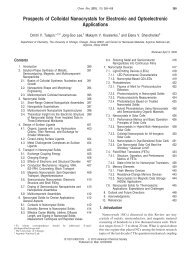File Systems and Disk Layout I/O: The Big Picture
File Systems and Disk Layout I/O: The Big Picture
File Systems and Disk Layout I/O: The Big Picture
Create successful ePaper yourself
Turn your PDF publications into a flip-book with our unique Google optimized e-Paper software.
Arm<br />
Track<br />
Rotational Media<br />
Head<br />
Sector<br />
Cylinder<br />
Platter<br />
Access time = seek time + rotational delay + transfer time<br />
seek time = 5-15 milliseconds to move the disk arm <strong>and</strong> settle on a cylinder<br />
rotational delay = 8 milliseconds for full rotation at 7200 RPM: average delay = 4 ms<br />
transfer time = 1 millisecond for an 8KB block at 8 MB/s<br />
B<strong>and</strong>width utilization is less than 50% for any noncontiguous access at a block grain.<br />
<strong>Disk</strong>s <strong>and</strong> Drivers<br />
<strong>Disk</strong> hardware <strong>and</strong> driver software provide basic facilities for<br />
nonvolatile secondary storage (block devices).<br />
1. OS views the block devices as a collection of volumes.<br />
A logical volume may be a partition ofasinglediskora<br />
concatenation of multiple physical disks (e.g., RAID).<br />
2. OS accesses each volume as an array of fixed-size sectors.<br />
Identify sector (or block) by unique (volumeID, sector ID).<br />
Read/write operations DMA data to/from physical memory.<br />
3. Device interrupts OS on I/O completion.<br />
ISR wakes up process, updates internal records, etc.<br />
2
















